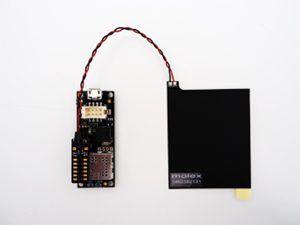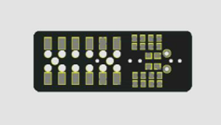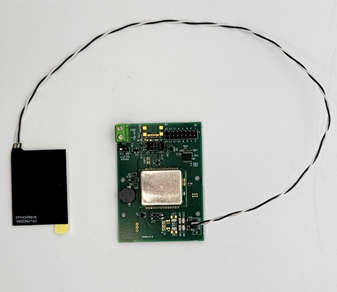External antenna choices
Your choice of external antenna will be affected by the type of enclosure you are using, the read range and performance required, and by the way that you plan to approach radio testing and certification of your end product.
There are two main approaches when selecting an external antenna
An off‑the‑shelf NFC antenna can be used with the VTAP50‑MOD, VTAP25‑MOD, and VTAP50‑OEM with its integrated antenna removed. Since these antennas do not typically come with a tuning circuit, a tuning circuit adaptor board will have to be installed between the VTAP reader and the antenna.
These antennas come in various sizes and form factors, offering integrators a range from which to select the best fit for their application. In space‑constrained scenarios, where a PCB antenna cannot be mounted near the surface of the outer housing, flexible thin antennas can be used which are pasted directly behind the front surface of the housing. This ensures there is no loss of range due to clearance between the outer housing and the NFC antenna, which is often needed for ventilation around a PCB antenna.
For VTAP50‑MOD and VTAP50‑OEM without its integrated antenna, the optional VTAP50‑M2 antenna tuning board can be tuned to the off-the-shelf antenna of your choice. This header is fitted to the VTAP50 12‑way J1 header. You can refer to Connect an external antenna to VTAP50-OEM for how to remove the integrated antenna. And see Matching circuit examples for tuning component values for some off‑the‑shelf antennas, if you want to take a blank VTAP50‑M2 tuning board and fit tuning components yourself.
For a VTAP25 module an off‑the‑shelf antenna could be chosen, with the tuning components mounted on the VTAP25 host board.
Dot Origin offers design support, to help you select the optimum off‑the‑shelf antenna for your application and/or antenna tuning. Dot Origin could design a VTAP50‑M2 tuning board, populated with the right tuning components for your selected antenna and host environment.
You could design and use a custom-made assembly that combines the VTAP reader with an NFC antenna and tuning components on a single board. This allows greater flexibility in antenna form factor, size, range and performance. This could be your only option if, for example, you need an antenna which will fit behind a housing with multiple cutouts, and off‑the‑shelf antenna options do not align with your size and shape constraints.
Dot Origin can offer a custom antenna design service for VTAP50 and VTAP25. This would include designing a suitable antenna for your application and performance requirements, along with a tuning circuit, together with limited compliance testing of the reader with its new antenna to support a permissive change approval.
Dot Origin can also provide design consultancy, if you prefer to design the antenna and tuning circuit yourself. This would include providing design information, then testing the custom antenna with the VTAP reader to support a permissive change approval.
Antenna size - range - performance trade-offs
In both off‑the‑shelf or custom antenna scenarios, size is an important factor when choosing the right antenna for your application. There are trade-offs between the antenna size, range and performance.
NFC interaction works when the NFC fields of the VTAP reader and the mobile phone or card have a good intersection. Deviating from the standard 40x40mm antenna size can reduce performance, in a variety of different ways. For example, using a smaller 15x25mm antenna might reduce NFC range to 35‑40mm, and using a much larger 80x80mm antenna could produce a field with a ‘dead zone’ in the centre, with poor field strength.
Range becomes important when custom antennas or non‑stickable, off‑the‑shelf antennas are fitted behind a front panel. You will lose some usable NFC range when you introduce a clearance, say 5‑10mm, between the front surface of the device and the antenna. We normally recommend you design for at least 40mm NFC range, from front surface of your final product, which is in line with the Apple ECP2/Access range requirement.
It is important to consider all these aspects when choosing your antenna. Please consult VTAP support at an early stage, to discuss your plans and requirements.


